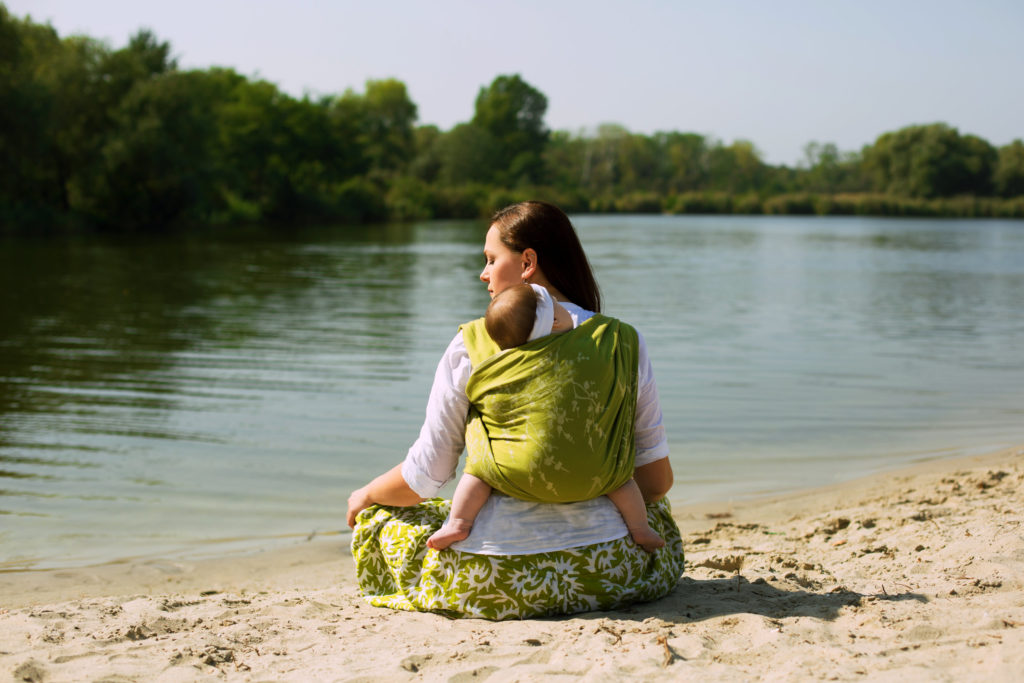It seems like the answer to this question should be straight forward. There are only so many ways how you can carry your baby: front carry, hip carry, and back carry. Those are the three basic carrying positions. But who is each carrying position best for and which carrier can you use?
This post is the third part of a three-part-series about carrying positions. Each post will give you an overview of the featured carrying position and some tips and tricks. You can find the first part of the series here and the second part here.
In the last part of this series, I would like to introduce you to the back carry. Now that my girl is nearly four years old, I am only ever carrying her on my back – not that I do carry her much anymore. I started back carrying her when she was about 8 months old. At that time, it was mainly when I wanted to cook dinner and she would have been in the way on my front. Later I enjoyed carrying her on my back, when being out on walks. This was much easier on my back and she had the advantage of seeing what I was seeing.
Who can you carry?
Back carries are great for older babies, toddlers, and young children. However, even younger babies can be worn on the back if the wearer is experienced and uses the right carrier.
The recommendation is that a child should be able to get into a sitting position by themselves. This way they will have the necessary strength in their backs and heads to support themselves when being carried on the back. This advice is mainly for buckle carriers (soft structured carriers) and onbuhimos.
If you are using a woven wrap or a well-fitting meh dai, you will be able to carrier your baby earlier on your back. Please only do so though if you are an experienced babywearer or have received instructions and support from a consultant. The risk being that you can’t see your child easily and therefore might have trouble checking if the airways are clear.
Which carrier can you use?
The only carrier that should not be used for back carries is the stretchy wrap. The stretch of the wrap will give your child too much room to move and the risk of falling is too high. A ring sling can technically be used for back carrying, but with weight distribution only over one shoulder is not the best carrier for back carries.
Woven wraps are great for back carrying as are meh dais. Most soft structured carriers are also perfect for back carrying especially because they have well-padded shoulder straps and waistbands.
The carrier that has been made for back carries though is the onbuhimo. This type of carrier is perfect for carrying older babies, toddlers, and even young children on your back.
How do you use an onbuhimo?
The most important thing to remember, when using an onbuhimo is that your child should be carried high up on your back. This will make it more comfortable for yourself and your child.
Wrap you in Love has this quick tutorial.
How do you safely get your child on your back when using a soft structured carrier?
The trickiest part of back carrying your child is the part where you need to get your child on your back. There are a few different ways, but I personally find this one to be the easiest and safest.
How can you wrap on the back?
Using a woven wrap for a back carry requires experience in wrapping and lots of practise. It is best to get advice and help from a babywearing consultant.
This tutorial from Wrap you in Love shows a simple back carry and a safe way how to get your baby on your back.
Tips and Tricks for back carrying
- Remember to wear your child high enough so he can easily look over your shoulder.
- If using a soft structured carrier, start with the waistband nice and high (right under your breasts).
- When back carrying the shoulder straps can also be crossed in the front to have better weight distribution.
- Use the hood of your carrier as a head support if your baby falls asleep on your back.
- When starting with back carrying it is best to get someone to help you put your child on your back.
- The “walk like an Egyptian” move can be safely used to get your child on your back by yourself (see tutorial above).
- When practising on your own, stand close to a bed or sofa, in case your child does fall.
Let me know…
Have you tried to carry your baby on your back yet? Which carrier do you like best for back carrying?
Please share with your friends:
